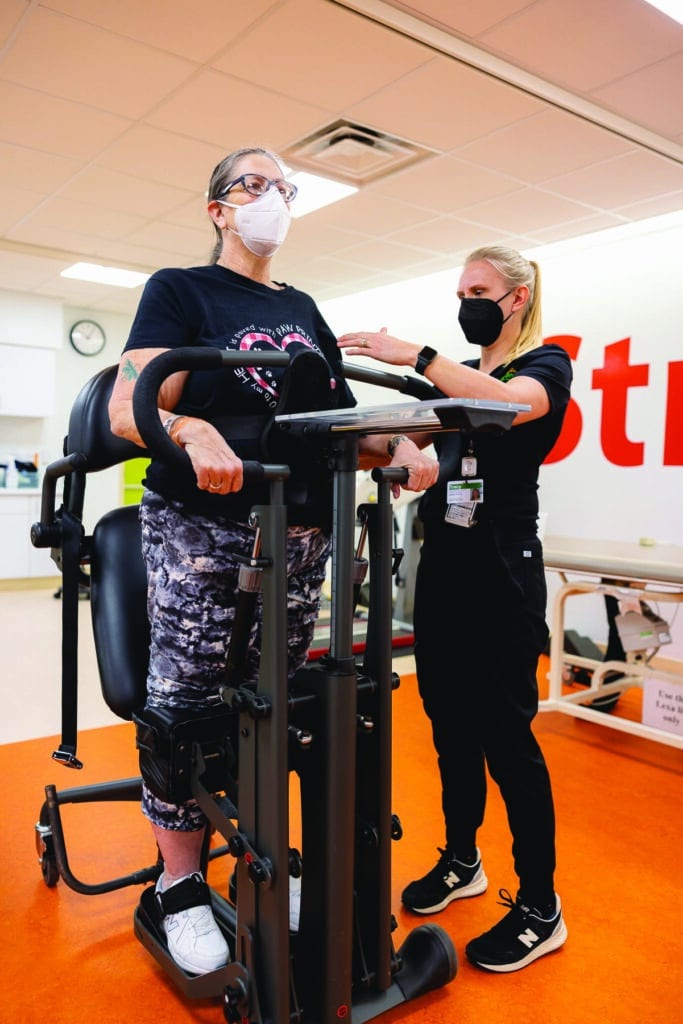PHOTO CAPTION: A harness and overhead dynamic body weight support system can help clients with spinal cord injuries progress to another phase in their treatment. Using standing systems first helps clients build up to using this equipment.
In a variety of cases, standing is safe, effective, and important for people with spinal cord injury.
By Tracy Oostema, PT, DPT
“Sitting is the new smoking” is a popular phrase first coined by James Levine, MD, PhD.1 While the sentiment’s merits are debatable, it certainly gives us pause. There are well-documented health consequences of sedentary living, including cardiovascular disease, obesity, and diabetes. In response, health initiatives have aimed at limiting the time people spend sitting. Standing desks and smart watch standing alerts have become commonplace.
But how does a bold statement like this affect the hundreds of thousands of people in the United States who use a wheelchair for mobility and for whom standing up is not a matter of motivation? How do healthcare providers such as physical therapists empower patients with neurologic conditions to overcome barriers that necessitate constant sitting and take a proactive stand for healthier living?
People with spinal cord injury (SCI) face unique health challenges and obstacles related to standing. Case studies can help us focus on implementation of standing protocols in the inpatient rehabilitation (IPR) setting, highlighting commonly used technology and translation of therapeutic standing into a home program.
Approximately 18,000 new spinal cord injuries occur annually in the United States with an incidence of approximately 54 cases per million people.2 Spinal cord injuries result in varying degrees of motor and sensory impairment, as well as altered autonomic nervous system function. People with SCI often require a wheelchair to accomplish some or all mobility and activities of daily living (ADLs). Several common secondary complications mimic those resulting from sedentary living, including cardiovascular disease and obesity. Other complications include spasticity, pressure ulcers, osteoporosis, and bone fractures.3
Reaping the Benefits
There are diverse and multi-system benefits of standing that can be experienced by people with SCI. These include:
- Pressure reduction on bony prominences with reduced incidence of pressure ulcers
- Maintenance of muscle length and joint range of motion4
- Cardiovascular conditioning5
- Spasticity management6
- Gravity-aided enhanced bowel and bladder function
- Improved posture
- Social and emotional well-being.
For people with volitional lower extremity movement, standing is an ideal position for lower extremity strengthening, particularly to load the quadriceps, which may provide an effective means to prevent distal femoral bone loss. It’s also a natural position for mobility progression from wheelchair to ambulatory-level activities, including gait, balance, and transfer training.
Tools of the Trade
In the rehabilitation environment, standing patients with SCI can be achieved through several means. More traditionally available options include parallel bars or platform walkers, coupled with trial orthotics and an “all hands on deck” approach. More complex equipment, if available and appropriate, can facilitate safe, early standing. Devices such as static or dynamic body weight support harness systems, standing frames, and tilt tables can be highly effective.
Options for home standing include a variety of assistive devices and orthotics and, when funding allows, standing frames and wheelchairs.
Experience
In the following case studies, the journeys of three people with SCI who underwent intense inpatient rehabilitation show how standing was successfully incorporated into their treatment programs and the results and implications for return to standing at home.
Complete Paraplegia
Patient A is a 68-year-old male who sustained a traumatic spinal cord injury as a result of a motor vehicle crash, resulting in L1 complete paraplegia.
He underwent a spinal fusion with orders for a thoracic lumbar spinal orthosis (TLSO) on when out of bed. Upon admission to IPR, the patient lacked active movement in his lower extremities, which remained unchanged through the course of treatment. He had an unstageable sacral pressure ulcer and poor sitting tolerance in a power wheelchair due to significant orthostatic hypotension (OH) with transfers out of bed.
Standing was initiated after he could tolerate sitting up in a power wheelchair with cardiac support devices (compression stockings, abdominal binder). A standard tilt table was introduced first to gradually transition to vertical, while allowing for immediate return to supine with episodes of symptomatic OH. When his TLSO was removed, standing activities transitioned to a tilt table with harness and robotic lower limb stepping, which provided lower extremity passive range of motion and aided in maintaining a stable blood pressure.
The patient stood in these devices two to three times per week for 30 to 60 minutes; upper extremity strengthening activities were coupled with standing. Given the patient’s absent lower extremity strength and need for support, overhead harness systems were not considered. Standing and ambulating with orthotics such as knee ankle foot orthoses (KAFO) also was not pursued due to heavy upper extremity lifting requirements and concern for age-related shoulder degeneration.
While return to functional gait was not a feasible goal, Patient A experienced positive effects from his standing program, including sacral pressure reduction, which aided in wound healing, maintenance of muscle length—particularly in the hip flexors and ankle plantar flexors—and the psychological benefits of being upright. The patient discharged at wheelchair level, but a power standing wheelchair was prescribed for a daily standing exercise program and to increase access within the home for ADLs.

Incomplete Paraplegia ASIA C
Patient B is a 71-year-old male diagnosed with a non-traumatic spinal cord injury, L1 incomplete paraplegia ASIA C, due to a spinal epidural abscess.
Following evacuation of the abscess, the patient was directed to wear a lumbar spinal orthosis (LSO) when out of bed. At admission, the patient presented with weakness in both lower extremities with less than full range of motion against gravity in all major muscle groups.
The patient’s initial standing in the parallel bars with two-person assist was not therapeutic due to a 10-second stand tolerance and maladaptively flexed posture. There was also a significant burden on therapy staff and concern for safety with knee buckling. A harness system would have been ideal for standing and gait progression but was contraindicated due to placement of the LSO. Instead, therapeutic standing was progressed with the use of a standing frame. Standing frames provide a secure knee block and assist sit-to-stand transitions with the ease of a lever, which the patient can eventually operate themselves. In standing, support at the hips and chest can be narrowed to facilitate erect posture or opened for more degrees of postural freedom. Good cardiovascular tolerance for sitting is required as there is no tilting or quick transition to supine position as with a tilt table.
Standing activities were implemented five times per week for 30 to 50 minutes, focusing on isometric glute, quad, and trunk strengthening; postural re-education; and progression of sit-to-stands from progressively lower seat heights. This training increased the patient’s confidence with standing and translated to improved function as he weaned from the standing frame and transitioned to standing and ambulating overground with a walker. At discharge, the patient was ambulating household distances with a rolling walker and minimal assistance. Patient B’s home standing program was simply to ambulate functionally and resume some of his pre-morbid household ADLs with a progressive reduction in time spent at wheelchair level.
Incomplete Tetraplegia ASIA C
Patient C, a 56-year-old male, also was involved in a motor vehicle crash, resulting in C6 incomplete tetraplegia ASIA C.
Following cervical fusion, Patient C wore a hard cervical collar at all times. Upon initial evaluation, he could elicit active movement in gravity-eliminated positions with one lower extremity; the other lacked active movement. Both upper extremities were weak with absent grasp, and he had a stage II coccygeal pressure ulcer, which made prolonged sitting painful. The patient struggled initially with orthostatic hypotension (OH), and he developed significant lower extremity spasticity throughout the course of treatment.
Early standing was implemented on the tilt table, gradually progressing both the degree of incline and the time tolerated in that position. Therapeutic exercise on the tilt table consisted of lower extremity isometrics and short-arc single leg knee flexion and extension with slack in the knee strap. With progression in strength and resolution of OH, the patient transitioned to standing with a harness and overhead dynamic body weight support (BWS) system.
Treatment there focused on sit-to-stands from a power wheelchair, static standing with emphasis on upright posture and gait with a platform walker, bilateral ankle foot orthoses (AFOs), and the assistance of three people. Initially, 40% BWS was required for these activities, but the patient gradually weaned off BWS and could stand from a wheelchair with AFOs and moderate assistance of two people. Standing, transfer, and gait activities were implemented five times per week for 30 to 60 minutes.
This patient’s standing program aided in spasticity management, pressure reduction that resulted in decreased pain and wound healing, and progression of functional mobility. Throughout the course of IPR the patient advanced from total assist mechanical lift transfers to squat pivot transfers with assistance of one family member. While he did not recover the ability to ambulate over ground without BWS, the strengthening and weight-bearing opportunities contributed significantly to his progress, particularly with emotional adjustment to his injury. While it was not safe to prescribe standing at home upon discharge, Patient C was expected to continue with standing, transfers, and gait training with in-home and outpatient physical therapy.
Summary
People with spinal cord injuries spend a great deal of time sitting. It’s often unavoidable. It’s almost always the most efficient way, but it certainly isn’t the only way. Standing is safe, effective, and important for people with SCI. With the appropriate equipment, education, and support it can be done successfully—the numerous physiological benefits warrant it. Taking a stand while living with SCI can reduce the severity of secondary health complications, improve psychological health, and contribute to a healthier life. RM
Tracy Oostema, PT, DPT, has been a physical therapist on the inpatient Spinal Cord Injury Team at Mary Free Bed Rehabilitation Hospital in Grand Rapids, Michigan, for 15 years. She treats patients with SCI and other complex neurological conditions. In addition to clinical care, Tracy serves as a clinical instructor for Doctor of Physical Therapy students and as a mentor in Mary Free Bed’s Neurologic Physical Therapy Residency program. She’s a graduate of Northwestern University Feinberg School of Medicine. For more information, contact [email protected].
References
- https://www.bizjournals.com/milwaukee/news/2018/10/22/why-sitting-is-the-new-smoking.html Referenced on 1/31/22
- https://www.nscisc.uab.edu/Public/Facts%20and%20Figures%20-%202021.pdf referenced on 1/31/22
- Sezer N, Akkus S, Uğurlu FG. Chronic complications of spinal cord injury. World J Orthop. 2015;6(1):24–33. doi: 10.5312/wjo.v6.i1.24.
- Newman M, Barker K. The effect of supported standing in adults with upper motor neuron disorders: a systematic review. Clin Rehabil. 2012;26(12):1059-77. doi: 10.1177/0269215512443373.
- Chi L, Masani K, et al. Cardiovascular response to functional electrical stimulation and dynamic tilt table therapy to improve orthostatic tolerance. J Electromyogr Kinesiol. 2008;18(6):900-7. doi: 10.1016/j.jelekin.2008.08.007.
- Adams MM, Hicks AL. Comparison of the effects of body-weight-supported treadmill training and tilt-table standing on spasticity in individuals with chronic spinal cord injury. J Spinal Cord Med. 2011;34(5):488-94. doi: 10.1179/2045772311Y.0000000028.
- McHencry CL, Shields RK. A biomechanical analysis of exercise in standing, supine and seated positions: Implications for individuals with spinal cord injury. J Spinal Cord Med. 2012;35(6):140-7. doi: 10.1179/2045772312Y.0000000011.





